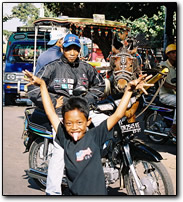Lombok
From Padangbai, a port in eastern Bali, we took the ferry to Lombok. As we approached the island, we could see white-sand beaches and dry palm trees across the light blue water. Rising above the beaches and bays were dry, scrubby hills. Lombok looked like a deserted island. The northern half of the island is dominated by the mighty Mt Rinjani. Near the giant cone, where enough water collects on the slopes, are rice paddies, but when the water runs out, further down the mountain, the soil is poor and only dry crops like corn and cassava can be grown.
 |
At the Mataram bus station, mobs of long-haired touts waited, trying to get us to go anywhere, so long as it was with them. We somehow avoided them, but when we did get to our next stop, there were again local touts crowding all around us, wanting to take us on their motorbike and telling us anything to convince us to follow them. They started to get excited but we calmed them down with our Indonesian. By now we knew how to deal with them and we soon found public transport, a pickup, going our way. The touts still hung around, though, half-trying to get us onto their motorbikes. The pickup driver asked us to move to the front seat of the pickup because a group of schoolgirls with headscarves were too afraid to sit in the back with us!
 |
 |
 |
Lombok was visibly Muslim, but most people were friendly and helpful, as they are everywhere in Indonesia. From our base in Tetebatu, south of Mt. Rinjani, we rented a motorbike and spent the next few days touring the local towns that specialize in crafts: pottery, basket-making and weaving.
 |
 |

